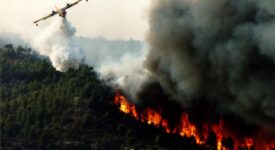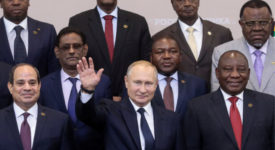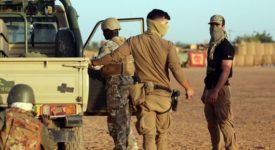New initiatives, operations and coalitions fighting terrorism in the Sahel appear regularly. One important negative side effect is that these operations often have severe repercussions for local populations. Indeed, throughout the first months of 2020, violence against civilians by Sahelian state security forces skyrocketed across Burkina Faso, Mali and Niger, as local and foreign forces intensified their operations. It is therefore crucial to assess the normative framework underlying these efforts and to critically review the assumptions inherent in the ‘fight against terrorism’ in the Sahel.
The idea of, and emphasis on, ‘the fight against the terrorists’ implies that there is a clearly delineated actor, namely ‘the terrorists’ (or as France often states ‘armed terrorist groups’) that are to be fought. This risks producing a simplified understanding of reality, as it implies a clear difference between ‘the population’ and ‘the terrorist’. Yet reality demonstrates that violent extremist groups skilfully blend in with the local population when necessary. In other words, the reality on the ground shows a much more confusing and complex reality than the ‘fight against the terrorists’ discourse suggests. This erroneous dichotomy is problematic as it increases the risk of human rights abuses.
Relatedly, whether the term ‘terrorist’ or the seemingly more nuanced terms ‘terrorism’, ‘armed terrorist group’ or ‘terrorist threat’ are used, the word ‘terrorist’ remains far from neutral. The use of the contested term ‘terrorist’ automatically delegitimises the ‘enemy’ against whom one fights, and leaves the insurgents and the fight devoid of any political content and context. Furthermore, this way of framing enables the actor fighting ‘the terrorists’ to decide who is and is not a legitimate political actor. In the Sahelian case, the G5 Sahelian governments are legitimised through the international community’s very act of cooperating and supporting their fight against the terrorists militarily as well as supporting the return of the state through security, political and development initiatives. Implicit in this cooperation with Sahelian states is the idea that the state represents all its people. Yet in reality, Sahelian governments struggle to be perceived as legitimate by their populations, most recently manifested in the Malian political crisis. Longstanding corruption and failure to foresee in the basic needs for all of the population have been detrimental to the governments’ perceived legitimacy.
Moreover, violent extremist groups skilfully capitalise on these governance vacuums by alternatively presenting themselves as suppliers of “key governance services”. This is not to neglect the fear of reprisal attacks that violent extremist groups instil among populations in case of disloyalty. However, the fact of the matter is that people support violent extremist groups for a variety of reasons, and the dichotomy of a ‘legitimate government’ versus ‘illegitimate terrorists’ that the fight against terrorism risks implying does not sufficiently consider the situation at hand. Besides, it is crucial to remember that the Sahelian conflict dynamics do not simply consist of a fight between ‘the Islamist terrorists’ and the G5 Sahel state and international actors, but that they are also produced, reinforced and exacerbated by (intercommunal) violence and atrocities by state security forces, ethnic militias and non-Islamist armed groups. All these different yet intertwined conflict dynamics need to be taken into account carefully in an adequate strategy to bring lasting peace and stability throughout the Sahel.
A third problematic aspect of the ‘fight against the terrorist threat’ framework is its risk of promoting a militarised approach. This is indeed an oft-heard criticism regarding the international Sahelian efforts. France, a key international actor in the military fight against terrorism alongside Sahelian armies, uses a strategy of first sufficiently weakening violent extremist groups militarily in order to pave the way for local armies to fight these groups ‘on their own’. Yet, it is rather unclear how this could succeed in the Sahelian context. Moreover, since the end of Operation Serval, violent extremist groups have demonstrated their resilience by spreading to and establishing themselves in other parts of the Sahel. Not only does this raise the question of whether such a strategy does not in fact give rise to more instability, it also leaves one wondering how effective this strategy is in the battle for legitimacy, rather than solely territory. This is not to suggest that the efforts in the Sahel are exclusively military or that no military actions should be taking place whatsoever. Yet, the question remains whether the current strategy in which military efforts are to be carried out before any other efforts like development or reconciliation initiatives take place, will truly bring the assumed stability on which lasting peace and security can be built.
Instead, by framing the situation at hand in terms of security threats, both by Sahelian and international actors, emphasis is placed on the ‘symptoms’ (i.e. ‘terrorism’) of the security crisis rather than on the root causes, in which long-standing lack of good governance plays a key role. This securitised discourse translates into a continued prioritisation of security measures both by Sahelian governments and international actors, often at the expense of sustainable development goals. Several international actors in the Sahel, including the French military, acknowledge that a real solution to the Sahel’s problems involves an adequate balance between soft security, including development initiatives and measures to improve governance, and hard security through military interventions. The problem is that this acknowledgement does not lead to change in the overall strategy in which ‘hard’ security measures continue to attract the most resources.
Even if the overall Sahelian strategy would be adjusted to focus more on development, a good balance between military and development initiatives alone is unlikely to bring lasting peace and security in itself. Ultimately, the Sahelian crisis is one of governance. “Terrorism”; recruitment by violent extremist groups, is enabled significantly through the governance vacuums that Sahelian governments have left. Yet, these governments are the very actors that international actors cooperate with in order to ‘stabilise’ the region. This seems to indicate a strategy of “fixing a car while driving it”, an expression ironically borrowed from the French army itself.
None of this is to suggest that we should pull out all international efforts from the Sahel. Yet, a critical assessment of the ‘fight against terrorism’ framework should make us rethink the current mode of action in the Sahel. Is the current militarized/securitized overall strategy not making matters worse? If one decides to work together with the governments of the Sahelian states, it is imperative to think about ways in which to pressure governments to bring about real change for all of the population. But ultimately, how can international actors truly give voice to Sahelian populations without deciding for them? To think about such questions and act upon the outcomes is imperative, as every action and word produced impact the future of the Sahel.
‚The ‚Fight Against Terrorism‘ in the Sahel Revisited‘ – Op-Ed by Anna Schmauder – Clingendael / The Netherlands Institute of International Relations.





